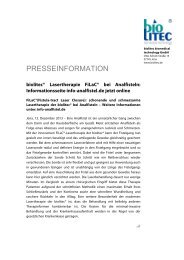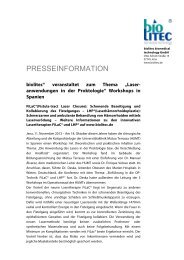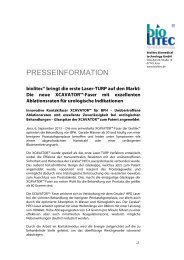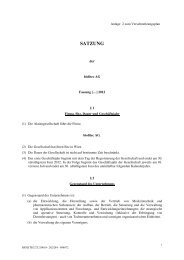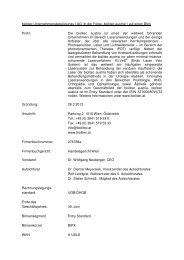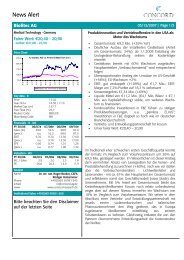Application of the biolitec EVOLVE Laser in interconventional ...
Application of the biolitec EVOLVE Laser in interconventional ...
Application of the biolitec EVOLVE Laser in interconventional ...
You also want an ePaper? Increase the reach of your titles
YUMPU automatically turns print PDFs into web optimized ePapers that Google loves.
Experience with <strong>biolitec</strong> <strong>EVOLVE</strong> TM<br />
The <strong>EVOLVE</strong> TM <strong>of</strong>fers a high spectrum <strong>of</strong> applications, also for <strong>the</strong> use <strong>in</strong> <strong>the</strong> <strong>in</strong>terventional<br />
bronchology. The diode laser has a wave length <strong>of</strong> 1470nm.<br />
The procedure used with<strong>in</strong> <strong>the</strong> bronchial system is dependent on <strong>the</strong> diagnostic f<strong>in</strong>d<strong>in</strong>gs.<br />
Normally tumors are ablated by fixed bronchoscopy. Here we additionally use <strong>the</strong> flexible<br />
bronchoscope under jet‐ventilation and general anes<strong>the</strong>sia with muscle‐relaxation via <strong>the</strong><br />
fixed pipe. This procedure is much safer. The fixed bronchoscope serves as access and tubus<br />
for ventilation. It allows <strong>the</strong> removal <strong>of</strong> <strong>the</strong> fiberscope at any time and <strong>the</strong> clean<strong>in</strong>g <strong>of</strong> <strong>the</strong><br />
lens and <strong>the</strong> laser fiber. The fiber is applied through <strong>the</strong> flexible bronchoscope and is<br />
controlled by a direct visible check with <strong>the</strong> help <strong>of</strong> <strong>the</strong> fiberscope and <strong>the</strong> pilot‐beam. If<br />
necessary, <strong>in</strong>terventions can be done through <strong>the</strong> fixed pipe, especially <strong>in</strong> cases <strong>of</strong> serious<br />
bleed<strong>in</strong>gs or if additional mechanical ablations are reasonable.<br />
At first, smaller tumors are coagulated <strong>the</strong>n vaporized before ablated totally without any<br />
bleed<strong>in</strong>g. It is especially <strong>of</strong> advantage work<strong>in</strong>g <strong>in</strong> non‐contact mode us<strong>in</strong>g a gas‐cooled<br />
CERALAS fiber. This leads to a cool<strong>in</strong>g‐effect and also to “clean<strong>in</strong>g” <strong>the</strong> surround<strong>in</strong>gs. The<br />
<strong>in</strong>itial sett<strong>in</strong>g we prefer is 15 to 20 Watts. With<strong>in</strong> small distance (only a few millimeters) to<br />
<strong>the</strong> tissue <strong>the</strong> pilot beam is run over <strong>the</strong> surface <strong>of</strong> <strong>the</strong> tumor until a whitely discolor<strong>in</strong>g can<br />
be seen. Normally <strong>the</strong> application period can be controlled by <strong>the</strong> pedal switch under visual<br />
check. By that a reduction <strong>of</strong> bleed<strong>in</strong>g can be achieved. After that tissue is ablated – if<br />
necessary by a stepwise <strong>in</strong>crease <strong>of</strong> power <strong>of</strong> 5 W at a time up to a total <strong>of</strong> 30 W – until<br />
reach<strong>in</strong>g <strong>the</strong> mucous membrane level. By do<strong>in</strong>g that, tissue is carbonated first, <strong>the</strong>n<br />
vaporized and f<strong>in</strong>ally it clears away. An important advantage <strong>of</strong> <strong>the</strong> laser is that it is a very<br />
precise and well controllable <strong>in</strong>strument for ablat<strong>in</strong>g tissue. Modifications are possible by<br />
chang<strong>in</strong>g <strong>the</strong> application period <strong>of</strong> <strong>the</strong> laser beam with <strong>the</strong> pedal switch and, if necessary, by<br />
<strong>in</strong>creas<strong>in</strong>g <strong>the</strong> laser power. Perforation is prevented by work<strong>in</strong>g gradually and from one layer<br />
to <strong>the</strong> next one. Navigation through <strong>the</strong> normal surface and <strong>the</strong> cont<strong>in</strong>uity <strong>of</strong> <strong>the</strong> airways<br />
helps not to get too deep <strong>in</strong>to <strong>the</strong> tissue and not to create a via falsa. The result <strong>of</strong> that is<br />
that a visual <strong>in</strong>sight <strong>in</strong>to <strong>the</strong> operation field is a precondition for work<strong>in</strong>g with a laser.<br />
For larger tumors an identical procedure is possible generally, sometimes even practical. This<br />
concerns especially strongly vascularized tumors with a higher bleed<strong>in</strong>g risk. The extended<br />
treatment duration is a disadvantage. With a comb<strong>in</strong>ed procedure us<strong>in</strong>g a fixed<br />
bronchoscope and a fiberscope a reduction <strong>of</strong> <strong>the</strong> treatment duration can be achieved<br />
through ablat<strong>in</strong>g exophytical parts mechanically ei<strong>the</strong>r primarily or secondarily after<br />
coagulation. For globular tumors <strong>the</strong> sl<strong>in</strong>g (mostly without electricity) is <strong>in</strong>creas<strong>in</strong>gly used <strong>in</strong><br />
bronchology. In o<strong>the</strong>r cases optical <strong>in</strong>struments like p<strong>in</strong>cers or scissors are used. Also <strong>the</strong> tip<br />
<strong>of</strong> <strong>the</strong> fixed pipe is an excellent and well‐tried <strong>in</strong>strument for ablation (so‐called cor<strong>in</strong>g out).<br />
But it is important to treat <strong>the</strong> basis <strong>of</strong> <strong>the</strong> tumor with <strong>the</strong> laser. The laser coagulation stops<br />
or reduces bleed<strong>in</strong>g. The coagulation <strong>of</strong> <strong>the</strong> basis also reduces <strong>the</strong> risk <strong>of</strong> re‐obstruction. The<br />
laser has a coagulation effect which reaches a few millimeters <strong>in</strong>to <strong>the</strong> wall. By that tumor<br />
cells are damaged <strong>in</strong> a way that it takes <strong>the</strong>m longer to grow new tumor tissue.<br />
‐ 3 ‐



